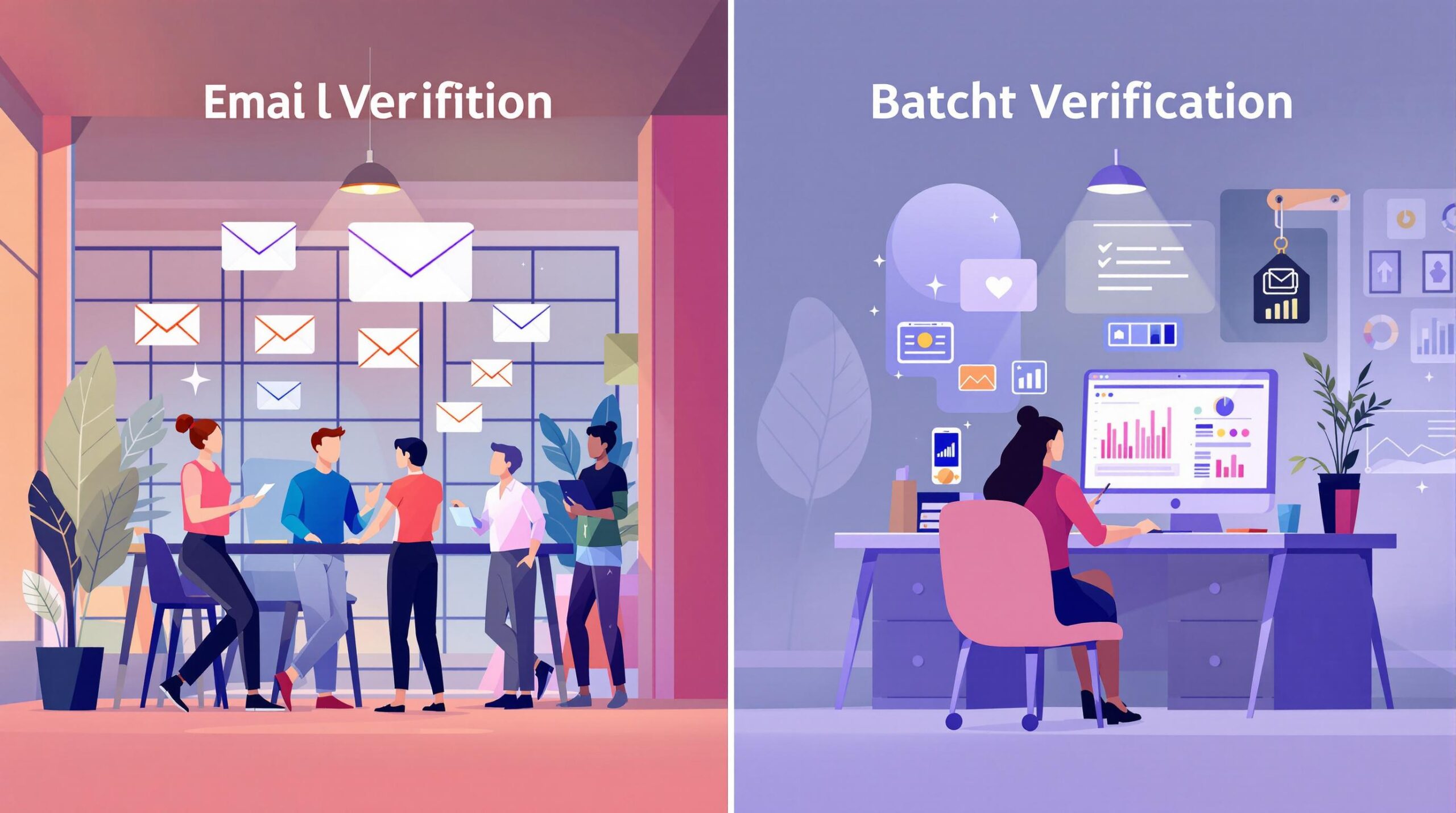Email verification helps businesses ensure clean, accurate email lists, improving communication, reducing costs, and maintaining sender reputation. Real-time verification checks emails instantly during entry, while batch verification cleans existing lists. Here’s how these methods are used across industries:
- E-commerce: Prevent invalid emails at signup and clean customer lists for campaigns.
- Lead Generation: Validate emails in forms and maintain databases for better ROI.
- Email Marketing: Lower bounce rates, boost deliverability, and protect reputation.
- User Account Creation: Block fake accounts and bots for secure signups.
- Customer Support: Ensure valid emails for faster, efficient ticket resolutions.
- Job Portals: Improve communication with candidates during hiring processes.
- Event Management: Validate attendee emails to ensure smooth communication.
Quick Comparison:
| Use Case | Real-Time Benefits | Batch Benefits |
|---|---|---|
| E-commerce | Catches typos, blocks disposable emails | Cleans old customer lists |
| Lead Generation | Filters invalid leads instantly | Cleans up post-event or webinar data |
| Email Marketing | Stops bad emails from entering lists | Reduces bounce rates for campaigns |
| User Account Creation | Blocks fake accounts and bots | Maintains database accuracy |
| Customer Support | Validates email during ticket creation | Keeps records clean and actionable |
| Job Portals | Ensures valid candidate emails | Updates and cleans talent databases |
| Event Management | Fixes errors during registration | Validates large attendee lists |
Both real-time and batch verification ensure better communication, lower costs, and higher engagement in any industry.
Email Verification API for bulk and real-time email verification
1. E-commerce Customer Registration
For e-commerce businesses, keeping communication channels open and effective is a top priority. That’s why having valid email addresses is so important. Real-time email verification during registration acts as a safeguard against invalid emails and delivery problems.
Combining real-time verification at sign-up with periodic batch verification ensures your email lists stay accurate both now and in the future.
Real-time Verification During Sign-up
- Instantly checks email validity as users type
- Catches typos and domain errors
- Blocks disposable email addresses
- Provides immediate feedback to users
Batch Verification for Existing Databases
- Cleans up old customer lists by removing invalid or outdated emails
- Prepares accurate lists for marketing campaigns
- Identifies inactive accounts
| Verification Type | Benefits | Best Uses |
|---|---|---|
| Real-time | Validates instantly, Improves user experience | New registrations, Account creation, Password resets |
| Batch | Cleans databases, Handles bulk tasks | Existing lists, Imported contacts, Legacy data |
Accurate email addresses are essential for transactional emails like order confirmations, which are key to customer satisfaction. REST APIs and plugins make it easy to integrate email verification into e-commerce platforms, while also ensuring compliance with GDPR and CCPA [1].
These tools not only improve email deliverability and engagement but also enhance overall customer experience. Plus, both real-time and batch email verification can significantly boost lead generation efforts outside of e-commerce.
2. Lead Generation Forms
Lead generation forms are key opportunities to maintain high-quality data, and email verification is a crucial part of that process. By allowing only valid email addresses into your database, you protect your sender reputation and improve the return on investment for your lead generation campaigns.
Why Real-Time Verification Matters
Real-time email verification checks addresses instantly as users fill out forms. This ensures the leads you collect are valid and saves you time and effort by filtering out invalid contacts right away.
Maintaining Databases with Batch Verification
Batch verification is a great way to clean up existing lead databases. It’s especially useful after events like trade shows or webinars, where the quality of collected data can vary widely. Running a batch check helps keep your database accurate and actionable.
Practical Tips for Implementation
Striking the right balance in your verification process is essential. While validation improves data quality, too many steps can hurt your conversion rates. For example, requiring only professional email addresses has been shown to reduce form conversions by 52% [1]. Instead, consider accepting both personal and work emails – 55% of professionals actually prefer using personal addresses when downloading resources.
Using an API for background validation can keep your forms user-friendly while maintaining data quality. Tools like Bouncebuster offer REST API solutions that make this process simple and help protect your domain reputation.
To further improve lead quality, combine email verification with phone number validation and data enrichment. Together, these steps ensure your leads are both accurate and valuable.
Email verification isn’t just for lead generation – it’s also critical for successful email marketing campaigns, where deliverability can make or break your efforts.
3. Email Marketing Campaigns
Email verification plays a key role in keeping your marketing campaigns effective. Clean email lists not only improve deliverability but also help you get the most out of your investment.
How It Affects Deliverability and Reputation
Sending emails to invalid addresses can damage your sender reputation. Internet Service Providers (ISPs) may flag your domain if they detect high bounce rates or hits to spam traps, which can hurt your deliverability.
Boosting Campaign Results
By verifying your email lists, you can lower bounce rates, improve open rates, and increase conversions. The result? Your emails land in the inboxes of people who are actually interested.
How to Implement Verification
- Real-time verification stops invalid addresses from being added to your list in the first place.
- Batch verification cleans up your existing database.
This two-step process works especially well for industries like e-commerce and subscription services, where email is a primary communication tool.
Tracking the Impact
Keep an eye on key metrics like bounce rates, deliverability, and engagement. A good benchmark is a bounce rate under 2% and delivery rates above 95%. Engagement metrics should reflect a 10–20% improvement after verification.
Don’t Skip Domain Authentication
To further improve deliverability, set up SPF, DKIM, and DMARC protocols. These show ISPs that you’re a trustworthy sender.
Tools like Bouncebuster make verification easier by identifying spam traps, disposable emails, and role-based accounts through bulk and real-time checks. Email verification also ensures smooth user account creation, allowing for better communication and activation.
sbb-itb-f42cab2
4. User Account Creation
Creating user accounts is a key moment where email verification ensures both data accuracy and security. Real-time checks during signup can block invalid emails, while periodic batch verification keeps your database clean over time.
Stopping Fake Accounts
Email verification acts as the first defense against fake accounts and bots. By checking for proper syntax, confirming domain validity, and verifying mailbox availability, businesses can protect their data, cut down on server costs, and maintain reliable analytics.
Streamlining the Verification Process
Integrating email verification at signup or other critical points helps strike a balance between security and a smooth user experience. This method keeps your system secure without adding unnecessary friction for users.
Protecting Against Common Risks
Modern email verification tools help tackle several common threats:
| Threat Type | How Verification Helps |
|---|---|
| Spambots | Blocks automated signups |
| Disposable Emails | Flags temporary or throwaway email addresses |
Best Practices and Measuring Success
To get the best results, use real-time verification through an API during signups and schedule regular batch checks to maintain database quality. Track success through metrics like lower bounce rates, fewer fake accounts, and higher user engagement. These steps not only keep your database accurate but also improve email deliverability and overall system health.
5. Customer Support Ticketing
Customer support ticketing systems play a key role in ensuring smooth communication and efficient operations. Email verification – both in real-time and batch processes – helps support teams maintain reliable communication channels, leading to better service and happier customers.
Improving Support Efficiency
Real-time email verification during ticket creation helps ensure that only valid email addresses are used. This reduces communication breakdowns, speeds up response times, and enhances customer satisfaction. It also saves agents from wasting time on undeliverable messages and keeps customer records accurate for future interactions.
Key Advantages of Automated Validation
| Aspect | Benefit for Support Teams |
|---|---|
| Response Time | Faster replies by avoiding invalid emails |
| Agent Productivity | Reduces wasted efforts on bad addresses |
| Customer Experience | Provides timely updates to customers |
| Data Quality | Keeps records clean and up-to-date |
Seamless Integration
Email verification can be integrated into ticketing systems using APIs. These APIs validate email addresses instantly during ticket creation without disrupting workflows. The process runs in the background, ensuring smooth operations without adding any extra steps for customers or support agents.
Ensuring Clean Data
Batch email verification helps maintain a clean database by removing outdated or invalid addresses. This prevents communication failures in ongoing cases and ensures that support teams can rely on accurate contact information for effective service. By integrating this into ticketing systems, teams can keep operations running smoothly while avoiding unnecessary disruptions.
6. Job Application Portals
Job application portals act as key connection points between employers and job seekers, making precise email communication vital for smooth hiring processes. Ensuring email accuracy helps maintain clean data and supports effective communication throughout recruitment.
Real-Time and Batch Verification
Real-time verification checks email addresses as candidates submit their applications, catching errors instantly and boosting communication reliability. For existing candidate databases, batch verification helps keep records up-to-date, reduces email bounce rates, and safeguards your domain’s reputation.
| Verification Stage | Impact on Hiring Process |
|---|---|
| Submission | Blocks invalid email entries |
| Initial Screening | Ensures candidates get updates |
| Interview Scheduling | Minimizes missed notifications |
| Offer Management | Confirms delivery of key documents |
Implementation and Benefits
Using APIs, portals can integrate email verification into the application process without disrupting the user experience. Accurate email records lead to better communication, making recruitment workflows more efficient.
Key Metrics
- Fewer bounced emails
- Increased candidate response rates
- Shorter time-to-hire
- Improved candidate satisfaction
To get the best results, combine real-time verification during application submissions with regular batch checks of your talent database. This dual approach ensures reliable communication at every stage of recruitment.
Just as email verification improves recruitment processes, it’s equally important for managing attendee data in event planning.
7. Event Registration and Management
Smooth event management depends on accurate email communication – from confirming registrations to sending last-minute updates. Verifying email addresses helps ensure everything runs efficiently while keeping attendees informed.
Registration and List Management
Real-time email verification catches typos and invalid addresses during registration, ensuring accurate entries and avoiding communication issues. For organizers juggling attendee lists from multiple sources, batch verification helps clean up and validate contact data, ensuring event updates reach the right people.
| Communication Stage | Purpose | Impact |
|---|---|---|
| Registration Form | Catch invalid entries | Fix errors immediately |
| Confirmation Email | Share key event details | Boost delivery rates |
| Updates & Reminders | Keep communication ongoing | Increase attendance rates |
| Post-Event Follow-up | Collect attendee feedback | Improve response rates |
Implementation and Results
Event platforms can use email verification tools like Bouncebuster to validate registrations instantly and clean up attendee lists. This process helps:
- Remove invalid entries from imported attendee lists
- Ensure event emails are delivered accurately
- Maintain high-quality contact data for future events
- Achieve delivery rates exceeding 98%
For best results, combine real-time verification during registration with regular batch cleaning of attendee databases. This approach ensures reliable communication throughout the event and streamlines event management.
Wrapping It Up
Email verification plays a key role in industries ranging from event management to job portals. Companies like MediaShares, with their near-zero bounce rates, and MuleSoft, achieving a 99% deliverability score, show how effective verification systems can make a real difference [2].
To get the most out of email verification, businesses should choose an approach that fits their needs:
| Verification Type | Best For | Key Benefits |
|---|---|---|
| Real-time | New data collection, Sign-up forms | Stops invalid entries, Improves user experience |
| Batch | Existing lists, Periodic updates | Cleans large lists efficiently, Simplifies scheduled maintenance |
Many organizations use both methods. Real-time verification stops bad data at the source, while batch verification ensures lists stay clean over time.
Real Results
Using email verification can lead to:
- Deliverability rates above 98%
- Lower marketing expenses
- Protection of sender reputation
- Increased engagement levels [3][4]
Tools like Bouncebuster make this process easier by offering verification features paired with API integration for seamless use.
No matter the industry, email verification supports clear communication, safeguards your sender reputation, and drives business outcomes. With email still being a key communication tool, implementing verification is essential for smooth operations and strong customer relationships.



